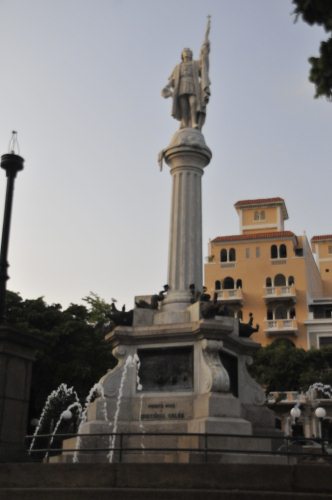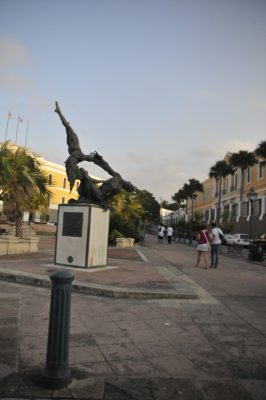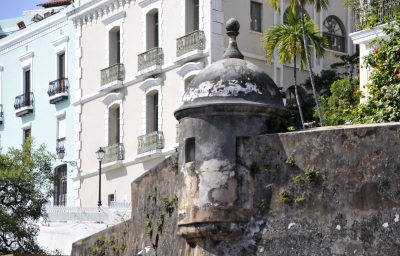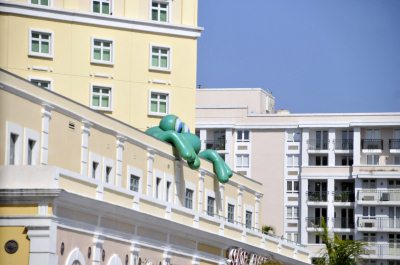Old San Juan

|
Old San Juan, Puerto Rico
We left Beez Neez with poorly batteries, awaiting Fernando, who had brought the wrong size, then didn't show up - now booked for next Tuesday, early. Off we went in our little Suzuki hire car seeking Old San Juan, another tick in the 1000 Places book. Soon after getting going we realised the maps here are one out of ten. You have to know if you are going north, south, east or west, know the next town you are heading toward, the number of the junction and roads change names, directions and end at the drop of a hat. With that in mind we decided to drop our stuff at the hotel and catch the bus for seventy five cents into town.
Old San Juan - Spanish: El Viejo San Juan, is the oldest settlement within the territory of the US, and is situated on a small, narrow island connected to the mainland by three bridges. Old San Juan lies on the north coast, about thirty five miles from the east end of Puerto Rico, it is bounded by the Atlantic Ocean to the north and to the south by San Juan Bay which lies between the city and the mainland. The most famous landmark is the battlements of Fort San Felipe del Morro. The city is characterised by its narrow cobblestone streets and flat-roofed brick and stone buildings dating back to the 16th and 17th century when Puerto Rico was a Spanish possession. Near del Morro is the Casa Blanca, a palace on land which belonged to the family of Ponce de Leon. The population of San Juan in 1899 was 23,556 (not including military and naval personnel) 7,963 in 2000
A view of Old San Juan I found on
the internet
History: In 1508, Juan Ponce de Leon founded the original settlement, Caparra (named after the Spanish province, Caceres, birthplace of the then-governor of Spain's Caribbean territories, Nicolas de Ovando). The ruins of Caparra are known as the Pueblo Viejo sector of Guaynabo, behind the almost land-locked harbour just to the west of the present San Juan metropolitan area. In 1509, the settlement was abandoned and moved to a site which was called at the time Puerto Rico, meaning "rich port" or "good port", a similar geographical harbour to that of Gran Canaria, Canary Islands. In 1521, the name "San Juan" was added, and the newer settlement was given its formal name of "San Juan Bautista de Puerto Rico", following the usual custom of christening the town with both its formal name and the name which Christopher Columbus had originally given the island honouring John the Baptist.
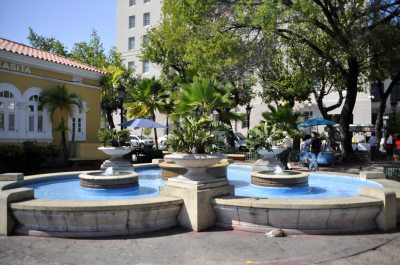 
The first thing we saw when we got off the bus was this very tired little chap, next to this fountain. Two cruise ships were in so the place buzzed, our friend has seen it all before. Prior to the 19th century the area outside the city walls occupying the east side of Old San Juan Island, was almost uninhabited. In 1838 the so called area of Puerta de Tierra or “Land Gate” had a population of only one hundred and sixty eight residents mainly of African descent. According to another census made in 1846, the population had risen to two hundred and twenty three inhabitants and there were a total of fifty eight houses. On the 3rd of March 1865, the municipal government of San Juan, approved a resolution promoting the city expansion across the land of Puerta de Tierra which included the plan for demolishing the city walls along the east side. On the 28th of May 1897, the demolition of the walls was officially started after a city expansion proclamation was issued by Queen Maria Christina. By the year 1899, the population of Puerta de Tierra had risen to 5,453 while the area comprising the old walled city had a civilian population 18,103 inhabitants.
 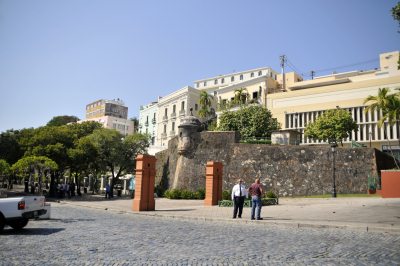
The Police Station roof was stunning and ornate. A part of the old city wall Old San Juan along with La Fortaleza were declared a World Heritage Site by UNESCO in 1983. The district is characterised by numerous public plazas and churches including San Jose Church and the Cathedral of San Juan Bautistae, which contains the tomb of the Spanish explorer Juan Ponce de Leon. It also houses the most ancient Catholic school for elementary education in Puerto Rico, the Colegio de Parvulos, built in 1865. With its abundance of shops, historic places, museums, open air cafés, restaurants, gracious homes, tree-shaded plazas, and its old beauty and architectural peculiarity, Old San Juan is a huge draw for tourists, the day we were there two cruise ships were in port. A free tourist trolleybus serves the city.
 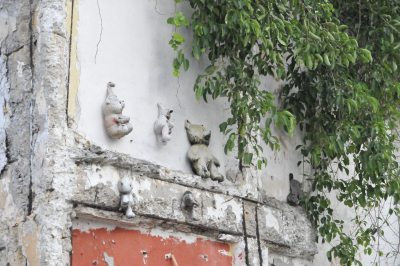
The free city bus that does circuits all day until 18:00. A bizarre sight was these bears painted or plastered on to the side of a house - glad Beds was back at the hotel.
Some views of the city and lastly, a huge blow-up frog above a restaurant called - the frog
ALL IN ALL AN INTERESTING CITY THAT SERIOUSLY GIVES YOUR FEET A HARD DAY
|



